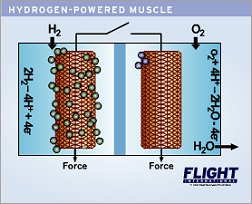Artificial “muscles” that could morph aircraft wings are a potential outcome of successful carbon nanotube fuel-cell and nickel titanium shape-memory alloy (SMA) research. Fuel cells and SMAs go through a chemically induced dimension change producing a muscle-like action that could be used to deform an aerofoil or drive a flapping wing. Wing morphing would facilitate the production of micro air vehicles which imitate the flight pattern of birds or insects.
 “We have made alcohol- and hydrogen-powered artificial muscles that are 100 times stronger than natural muscles,” says Ray Baughman, director of the University of Texas at Dallas’s Nanotech Institute.
“We have made alcohol- and hydrogen-powered artificial muscles that are 100 times stronger than natural muscles,” says Ray Baughman, director of the University of Texas at Dallas’s Nanotech Institute.
The research was supported by $750,000 of discretionary funding from US Defense Advanced Research Projects Agency’s Defense Research Office. Funding runs until the end of this month.
The fuel cell consists of carbon nanotube sheets impregnated with platinum particles (see diagram). Alcohol or hydrogen fuel injected into the cell reacts with the platinum, causing a dimension change due to a combination of nanoscale quantum mechanical and electrostatic effects.
SMAs, meanwhile, shorten when exposed to heat, in a reaction involving atmospheric oxygen, a fuel and a catalyst, and lengthen again on cooling.
ROB COPPINGER / LONDON
Source: Flight International




















